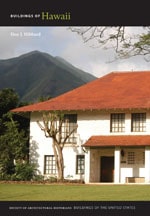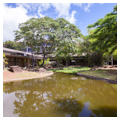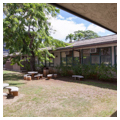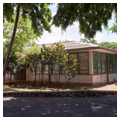You are here
Krauss Hall (Pineapple Research Institute)
This frame building, with its encircling, balustraded lanai, reflects the modest charm of Hawaiian-style architecture of the 1920s and 1930s. The building relies on its steep, sheltering, double-pitched hipped roof broken simply by a round-arched, classical dormer to mark its presence. A portion of the building was converted into the John Young Museum of Art in 1991. Preservation architects Urban Works retained the single-wall appearance of the building, but installed double walls for insulation purposes. The single-story masonry addition on the makai side of the original building was constructed in 1948, following the design of Richard Windisch. Richard C. Tongg and Lorraine Kuck laid out the courtyard with its pool. The makai wing of the building was demolished in the 1990s as part of a sewer replacement project along Dole Street. The moss rock wall was constructed to retain the character of the courtyard.
Writing Credits
If SAH Archipedia has been useful to you, please consider supporting it.
SAH Archipedia tells the story of the United States through its buildings, landscapes, and cities. This freely available resource empowers the public with authoritative knowledge that deepens their understanding and appreciation of the built environment. But the Society of Architectural Historians, which created SAH Archipedia with University of Virginia Press, needs your support to maintain the high-caliber research, writing, photography, cartography, editing, design, and programming that make SAH Archipedia a trusted online resource available to all who value the history of place, heritage tourism, and learning.














